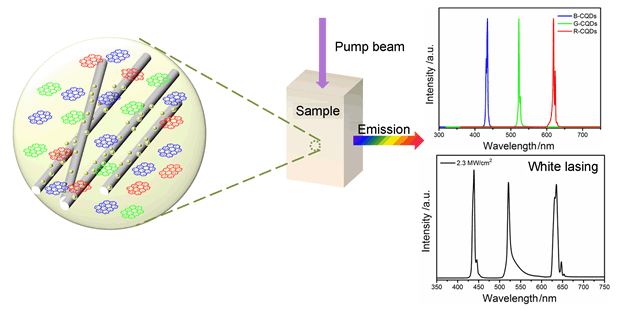| [1] Hill, M. T.; Gather, M. C. Nat. Photonics 2014, 8, 908.
[2] Luan, F.; Gu, B.; Gomes, A. S. L; Yong, K. T.; Wen, S. C.; Prasad, P. N. Nano Today 2015, 10, 168.
[3] Wiersma, D. Nat. Phys. 2008, 4, 359.
[4] Wiersma, D. Nature 2000, 406, 132.
[5] Wang, Y.; Duan, Z. J.; Qiu, Z.; Zhang, P.; Wu, J. W.; Zhang, D. K.; Xiang, T. X. Sci. Rep. 2017, 7, 8385.
[6] Polson, R. C.; Vardeny, Z. V. Appl. Phys. Lett. 2004, 85, 1289.
[7] Fan, F.; Turkdogan, S.; Liu, Z. C.; Shelhammer, D.; Ning, C. Z. Nat. Nanotechnol. 2015, 10, 796.
[8] Liu, Z. C.; Yin, L. J.; Ning, H.; Yang, Z. Y.; Tong, L. M.; Ning, C. Z. Nano Lett. 2013, 13, 4945.
[9] Lu, Y. J.; Wang, C. Y.; Kim, J.; Chen, H. Y.; Lu, M. Y.; Chen, Y. C.; Chang, W. H.; Chen, L. J.; Stockman, M. I.; Shih, C. K.; Gwo, S. Nano Lett. 2014, 14, 4381.
[10] Cai, P.; Jia, Y.; Feng, X. Y.; Li, J.; Li, J. B. Chin. J. Chem. 2017, 35, 881.
[11] Huang, L.; Li, Z. C.; Huang, S. Q.; Reiss, P.; Li, L. Acta Chim. Sinica 2017, 75, 300(in Chinese). (李志春, 黄寿强, Peter Reiss, 李良, 化学学报, 2017, 75, 300.)
[12] Shao, Y. B.; Yue, J. L.; Sun, S.; Xia, H. Chin. J. Chem. 2017, 35, 73.
[13] Li, C. L.; Zang, Z. G.; Han, C.; H, Z. P.; Tang, X. S.; Du, J.; Leng, Y. X.; Sun, K. Nano Energy 2017, 40, 195.
[14] Li, Y. J; Lv, Y. C.; Zou, C. M.; Zhang, W.; Yao, J. N.; Zhao, Y. S. J. Am. Chem. Soc. 2016, 138, 2122.
[15] Veldhuis, S. A.; Boix, P. P.; Yantara, N.; Li, M. J.; Sum, T. Z.; Mathews, N.; Mhaisalkar, S. G. Adv. Mater. 2016, 28, 6804.
[16] Rauter, P.; Capasso, F. Laser Photonics Rev. 2015, 11, 565.
[17] Li, T. F.; Li, Y. W.; Xiao, L.; Yu, H. T.; Fan, L. Z. Acta Chim. Sinica 2014, 72, 227(in Chinese). (李腾飞, 李昳玮, 肖璐, 余洪涛, 范楼珍, 化学学报, 2014, 72, 227.)
[18] Du, F. K.; Xu, J. S.; Zeng, F.; Wu, S, Z. Acta Chim. Sinica 2016, 74, 241(in Chinese). (杜方凯, 徐江生, 曾钫, 吴水珠, 化学学报, 2016, 74, 241.)
[19] Li, S. H.; Zhou, S. X.; Li, Y. C.; Li, X. H.; Zhu, J.; Fan, L. Z.; Yang, S. H. ACS Appl. Mater. Interfaces 2017, 9, 22332.
[20] Liu, Y. T.; Zhou, S. X.; Fan, L. Z.; Fan, H. Microchim. Acta 2016, 183, 2605.
[21] Xie, R. B.; Wang, Z. F.; Yu, H. T.; Fan, Z. T.; Yuan, F. L.; Li, Y. C.; Li, X. H.; Fan, L. Z.; Fan, H. Electrochim. Acta 2016, 201, 220.
[22] Guo, R. H.; Zhou, S. X.; Li, Y. C.; Li, X. H.; Fan, L. Z.; Voelcker, N. H. ACS Appl. Mater. Interfaces 2015, 7, 23958.
[23] Li, S. H.; Li, Y. C.; Gao, J.; Zhu, J.; Fan, L. Z.; Li, X. H. Anal. Chem. 2014, 86, 1021.
[24] Fan, Z. T.; Zhou, S. X.; Garcia, C.; Fan, L. Z.; Zhou, J. B. Nanoscale 2017, 9, 4928.
[25] Yuan, F. L.; Ding, L.; Li, Y. C.; Li, X. H.; Fan, L. Z.; Zhou, S. X.; Fang, D. C.; Yang, S. H. Nanoscale 2015, 7, 11727
[26] Fan, Z. T.; Li, S. H.; Yuan, F. L.; Fan, L. Z. RSC Adv. 2015, 5, 19773.
[27] Yuan, F. L.; Li, S. H.; Fan, Z. T.; Meng, X. Y.; Fan, L. Z.; Yang, S. H. Nano Today 2016, 11, 565.
[28] Xie, R. B.; Wang, Z. F.; Liu, Y. T.; Fan, L. Z.; Li, Y. C.; Li, X. H.; Anal. Methods 2016, 8, 4001.
[29] Pan, L. L.; Sun, S.; Zhang, A. D.; Jiang, K.; Zhang, L.; Dong, C. Q.; Huang, Q.; Wu, A. G.; Lin, H. W. Anal. Methods 2012, 4, 58.
[30] Wang, Z. F.; Yuan, F. L.; Li, X. H.; Li, Y. C.; Zhong, H. Z.; Fan, L. Z.; Yang, S. H. Adv. Mater. 2017, 29, 1702910.
[31] Yuan, F. L.; Wang, Z. B.; Li, X. H.; Li, Y. C.; Tan, Z. A.; Fan, L. Z.; Yang, S. H. Adv. Mater. 2017, 29, 1604436.
[32] Xie, W. J.; Fu, Y. Y.; Ma, H.; Zhang, M.; Fan, L. Z. Acta Chim. Sinica 2012, 70, 2169(in Chinese). (谢文菁, 傅英懿, 马红, 张沫, 范楼珍, 化学学报, 2012, 70, 2169.)
[33] Zhang, M.; Bai, L. L.; Shang, W. H.; Xie, W. J.; Ma, H.; Fu, Y. Y.; Fang, D. C.; Sun, H.; Fan, L. Z.; Han, M.; Liu, C. M.; Yang, S. H. J. Mater. Chem. 2012, 22, 7461.
[34] Fan, Z. T.; Li, Y. C.; Li, X. H.; Fan, L. Z.; Zhou, S. X.; Fang, D. C.; Yang, S. H. Carbon 2014, 70, 149.
[35] Tan, X. Y.; Li, Y. C.; Li, X. H.; Zhou, S. X.; Yang, S. H. Chem. Commun. 2015, 51, 2544.
[36] Shi, X. Y.; Wang, Y. R.; Wang, Z. N.; Wei, S. J.; Sun, Y. Y.; Liu, D. H.; Zhou, J.; Zhang, Y. Y.; Shi, J. W. Adv. Optical Mater. 2014, 2, 88.
[37] Chen, R.; Utama, M. I. B.; Peng, Z. P.; Peng, B.; Xiong, Q. H.; Sun, H. D. Adv. Mater. 2011, 23, 1404. |
